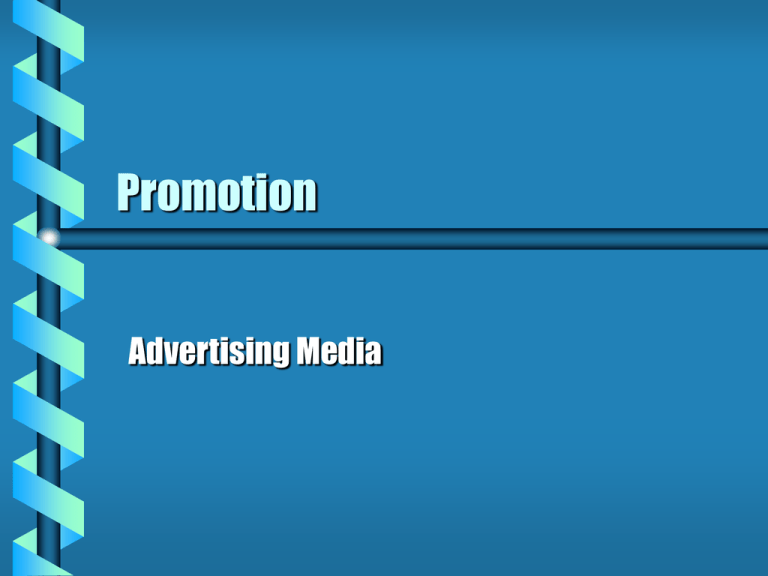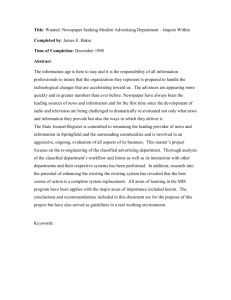Advertising Presentation
advertisement

Promotion Advertising Media How Many Ads to You See Each Week? The average person is exposed to approximately 2000 ads each week. Do you see that many or more? What is advertising? Advertising is any paid form of non- personal presentation and promotion of ideas, goods or services by an identified sponsor. • The time or space devoted to it is paid for • It uses a set format to carry the message rather than personal, one-on-one selling • It identifies the sponsor of the message How does advertising use a set format? Advertisements are measured by time or space • A radio spot is usually 30 seconds long (time) • A newspaper ad can be 1/4 page (space) The Main Purpose of Advertising To sell products or ideas by presenting its message so well that the customer will buy the product or accept the idea presented. Promotional Advertising Promotional advertising is advertising that is designed to increase sales by • • • • • creating an interest in products introducing new products and businesses explaining a product supporting personal selling efforts creating new markets Institutional Advertising Institutional advertising attempts to create a favorable impression (image) and goodwill for a business or an organization • Purpose is to develop a positive image by presenting information about a company’s role in the community, important public issues and topics of general interest. Media Media are the agencies, means or instruments used to convey messages Three Categories of Advertising Media Print media Broadcast media Specialty media Print Media Print media can include any of the following: • • • • • • Newspapers Direct Mail Magazine Outdoor Advertising Directory Advertising Transit Advertising Why is Newspaper Advertising Important? Approximately 55% of adults read the newspaper everyday? Do you read the newspaper? Do your parents or guardians read the newspaper? National, State and Local U.S.A. Today The Wall Street Journal The New York Times The Atlanta Journal/Constitution What is a shopper? Someone who likes to shop? A community newspaper which contains no editorial content and is delivered free to persons who live in certain areas (full of ads) The Thrifty Nickel Advantages & Disadvantages of Newspaper Advertising Large readership Known circulation (easy to target) Low cost Timely and flexible • Wasted circulation • Disposable (short lifespan) • Poor quality advertising Magazine Classifications Local Regional National weeklies Monthlies Quarterlies Consumer Vs. Business Consumer magazines are read for personal pleasure or interest • Reader’s Digest, Vogue, Sports Illustrated • Business magazines appeal to people with general interest in business or a particular field within business – Business Week, Inc., Forbes, Marketing News Advantages & Disadvantages of Magazine Advertising Easy to target your market Read slowly and thoroughly Good print quality Longer life span because they are kept of an extended period of time • Less mass appeal within a geographic area • More expensive than newspapers • Not timely or flexible (long lead times) Direct Mail Advertising (Junk Mail) Advertising that is sent directly to prospective customers through the mail (More than $80 billion in goods and services sold annually through direct mail) Have you ever bought anything through direct mail advertising? What do you do with it when you get it? Advantages & Disadvantages of Direct Mail Advertising Advertiser can be highly selective Flexible and secretive Wide choice of formats Can use coupons or other incentives Can directly make the sale • Low level of response (-1%) • High costs • Poor image (junk mail) often not read Outdoor Advertising Non-standardized outdoor signs are used by local firms at their place of business or in other locations throughout the community. Standardized outdoor signs are available to local, regional or national advertisers. Three types of standardized outdoor signs Posters - Preprinted sheets put up like wallpaper on outdoor billboards (McDonalds) Painted bulletins - Painted billboards that are changed every 6 months to a year Spectaculars - outdoor signs using lights, moving parts and are situated in high traffic areas or cities (Chick-Fil-A) Advantages and Disadvantages of Outdoor Advertising Highly visible Relatively inexpensive Permits easy repetition of message Can be geographically tailored for target market • Short message due to limited viewing time • Unknown audience • Government regulations Directory Advertising Alphabetical listing of businesses • • • • • Relatively inexpensive Found in 98% of households - all demographics Kept for at least a year - not thrown away Very inflexible due to being printed yearly Wasted advertising (to non-target market) Transit Advertising Using public facilities to advertise - such as subways, on buses and taxis, in stations Reaches a wide and captive audience Economical Defined market (usually urban) • Unavailable in smaller towns • Subject to defacement • Restricted to certain travel destinations Broadcast Media Radio - 6+ years listening to the radio Television - 10+ years watching television in 70 years Radio Advertising 96% of people over 12 are reached by radio Prime time is morning and afternoon drive times - advertisers guaranteed concentrated audience Ads are available in 15, 30 or 60 second time slots Advantages and Disadvantages of Radio Advertising Select and audience target their market Flexible - can change quickly and easily Mobile (can be taken anywhere - shopping, jogging, hiking or driving Short life span Sometimes many stations - have to decide which to use or use them all (more expensive) Distractions - no visual involvement Television Advertising The ultimate advertising medium because it can communicate with sound, action and color Prime time is 7 p.m. - 11 p.m. Infomercials - 30 minute commercials (The George Foreman Grill) Advantages & Disadvantages of Television Advertising All elements for creative message Believability More personal & effective Can reach the masses or target specific interests Adaptable to special needs Expensive - the highest production costs - too high for small businesses Audience size is not assured Nuisance - channel surfing - leave during commercials Advertising in U.S. Schools Some oppose Channel One because they believe the station misuses valuable educational time. Others are offended by commercialization of the school environment Advertisers hope students will become more aware of and ultimately buy their products. Disadvantages include the perception that the advertisers are forcing students to watch TV advertising or use a particular product College recruiters, yearbook ads, candy sale posters Some people may see advertising in schools as forcing products on a captive audience or may perceive businesses as taking advantage of schools Specialty Media Inexpensive, useful items with an advertiser’s name printed on them usually given away Other Types of Advertising Media Sports Arena Billboards Movie theater commercials Hot air balloons, blimps, skywriting, banners shelf ads, shopping cart ads, coupon machines, receipt ads Is there anything else we are missing? What about the Internet? What advantages and disadvantages might there be? Media Rates - Services Available Standard Rate and Data Service - gives rates for most major media according to broad categories (print, broadcast) Audit Bureau of Circulation (ABC) - Print media use this to verify circulation figures because advertising rates are based on circulation Classified Ads and Display Ads Classified ads can advertise everything from services performed to houses for sale to job openings (costs per word used) Display ads are creative illustrations of the product being advertised. (costs for space used) Newspaper Rates Column Inch Rates - number of columns by number of inches deep multiply by the rate Run of Paper rate - The newspaper chooses where to run the ad - you don’t choose the location Open Rate - Basic charge for a minimum amount of space (non-contract rate) Contract Rate - Discounted rates for guaranteed amount of advertising in a time period CPM CPM is the cost per thousand rate - the cost of exposing 1000 readers to an ad Cost of the ad X1000 = cost per thousand (cpm) Circulation Used to compare the rates for different papers with different circulations Magazine Rates Bleed - 1/2 or full page ads are printed to the very edge (no white border) +15-20% Black & White - Lowest rates - black & white ads Color - Each color adds more cost Full color - 4 color Premium position - ad placement in mag. Discounts - frequency, commission, cash CPM - Cost per thousand in circulation The Spot Spot radio refers to the geographical area an advertiser wants to reach with its advertising. Identify target market & potential customers Spot commercials are advertising messages of one minute or less that can be carried on network or spot radio. Different radio advertising options Network Radio advertising - a broadcast from a studio to all affiliated radio stations throughout the country (Paul Harvey) National spot radio advertising - National firms advertise on a local station-by-station basis. target markets Local radio advertising - local businesses advertise for its target market Run of schedule - lets the radio station determine when to run the advertisement Television Rates Advertising rates vary with the time of day. Prime time is the most expensive - 7-11 p.m. Class AA time is prime time - other times are Class A, B, C and D. Advertisers need to choose the time slot that receives the most viewers in their target market.



